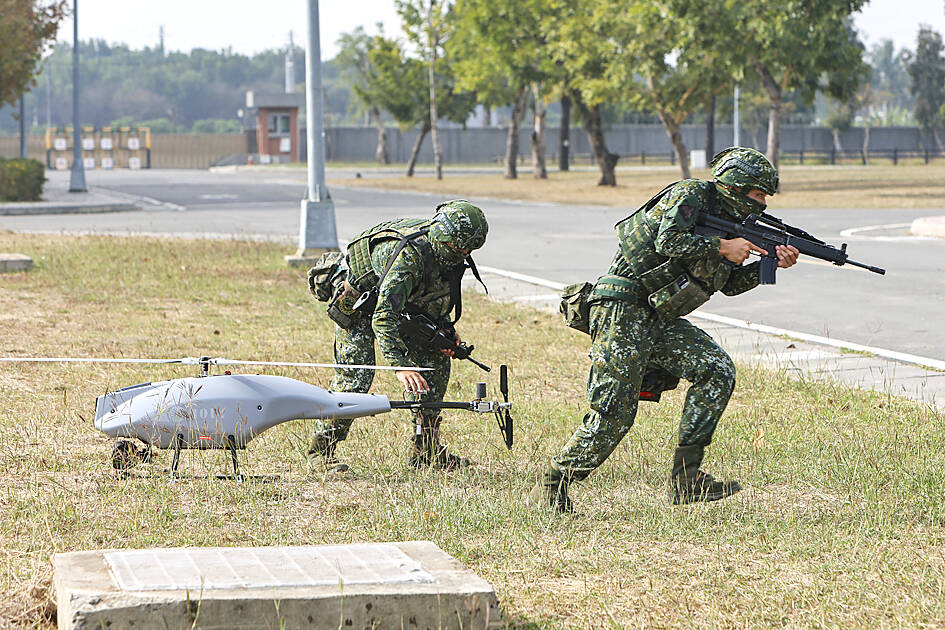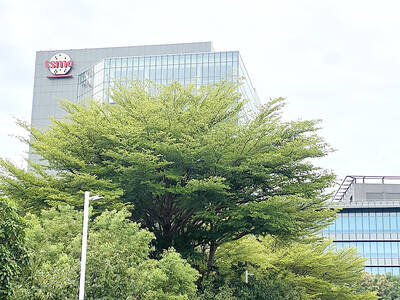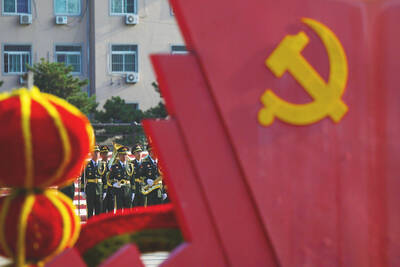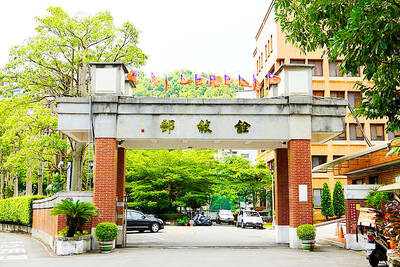The military yesterday unveiled the nation’s indigenous close-range tactical uncrewed aerial vehicle during a battalion exercise in Kaohsiung.
It was the first public appearance of the drone developed by the Chungshan Institute of Science and Technology.
The Third Combined Arms Battalion, 564th Armored Brigade carried out the anti-air assault exercise near an army base in Kaohsiung, with members of the media attending.

Photo: Daniel Ceng, AP
The drones — which resemble miniature helicopters — were utilized by a reconnaissance platoon in the battalion’s mortar company to detect and target enemy positions, the platoon’s second-in-command told a post-exercise news conference.
Real-time visual information provided by the system enables the battalion to engage opposing forces without a direct line of sight, he said, adding that the drones’ ease of use inspires confidence in troops.
Drone operators receive two weeks of training and undergo refresher courses once every two years, he said.

Photo: Daniel Ceng, AP
The 180cm long and 39cm wide drones have a maximum speed of 64kph and a service ceiling of 1,500m, and are capable of flying in Beaufort scale 6 winds, the army said in a statement.
The field exercise pitted the battalion’s armored and mechanized units against an opposing force portrayed by troops landing in Boeing CH-47 Chinook helicopters.
The purpose of the drill was to enhance the battalion’s ability to fight as an independent tactical unit, which requires mastery of command and control, field reconnaissance and surveillance, combined arms tactics, air defense and the use of fires, an army spokesperson said.
This week, the military is staging drills intended to reassure the public of its ability to counter China’s threats ahead of the Lunar New Year holiday.
Separately, the Ministry of National Defense posted a procurement notice to obtain 100AIM-X Block II Sidewinder tactical missiles from the US at a cost of NT$2.4 billion (US$78.86 million), with delivery to be completed by late 2030.
The advanced heat-seeking missiles for Taiwan’s F-16 jets are part of a larger deal signed by a delegation from the armed forces and the American Institute in Taiwan, the de facto US embassy in Taipei, a ministry official said on condition of anonymity.
The transfer of the missiles, four tactical guidance units, spare parts and other related equipment was one of the three arms deals the US Defense Security Cooperation Agency announced in September last year, the official said.

Taiwan Semiconductor Manufacturing Co (TSMC, 台積電) is expected to start construction of its 1.4-nanometer chip manufacturing facilities at the Central Taiwan Science Park (CTSP, 中部科學園區) as early as October, the Chinese-language Liberty Times (the Taipei Times’ sister newspaper) reported yesterday, citing the park administration. TSMC acquired land for the second phase of the park’s expansion in Taichung in June. Large cement, construction and facility engineering companies in central Taiwan have reportedly been receiving bids for TSMC-related projects, the report said. Supply-chain firms estimated that the business opportunities for engineering, equipment and materials supply, and back-end packaging and testing could reach as high as

CHAMPIONS: President Lai congratulated the players’ outstanding performance, cheering them for marking a new milestone in the nation’s baseball history Taiwan on Sunday won their first Little League Baseball World Series (LLBWS) title in 29 years, as Taipei’s Dong Yuan Elementary School defeated a team from Las Vegas 7-0 in the championship game in South Williamsport, Pennsylvania. It was Taiwan’s first championship in the annual tournament since 1996, ending a nearly three-decade drought. “It has been a very long time ... and we finally made it,” Taiwan manager Lai Min-nan (賴敏男) said after the game. Lai said he last managed a Dong Yuan team in at the South Williamsport in 2015, when they were eliminated after four games. “There is

Democratic nations should refrain from attending China’s upcoming large-scale military parade, which Beijing could use to sow discord among democracies, Mainland Affairs Council Deputy Minister Shen You-chung (沈有忠) said. China is scheduled to stage the parade on Wednesday next week to mark the 80th anniversary of Japan’s surrender in World War II. The event is expected to mobilize tens of thousands of participants and prominently showcase China’s military hardware. Speaking at a symposium in Taichung on Thursday, Shen said that Chinese Minister of Foreign Affairs Wang Yi (王毅) recently met with Indian Prime Minister Narendra Modi during a visit to New Delhi.

FINANCES: The KMT plan to halt pension cuts could bankrupt the pension fund years earlier, undermining intergenerational fairness, a Ministry of Civil Service report said The Chinese Nationalist Party (KMT) caucus’ proposal to amend the law to halt pension cuts for civil servants, teachers and military personnel could accelerate the depletion of the Public Service Pension Fund by four to five years, a Ministry of Civil Service report said. Legislative Speaker Han Kuo-yu (韓國瑜) on Aug. 14 said that the Act Governing Civil Servants’ Retirement, Discharge and Pensions (公務人員退休資遣撫卹法) should be amended, adding that changes could begin as soon as after Saturday’s recall and referendum. In a written report to the Legislative Yuan, the ministry said that the fund already faces a severe imbalance between revenue